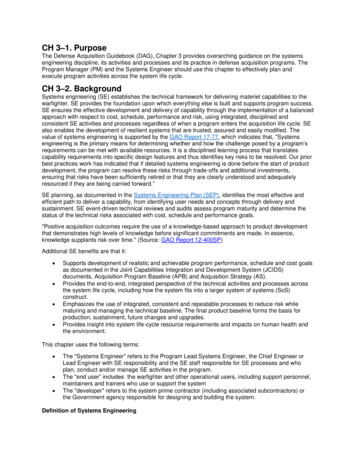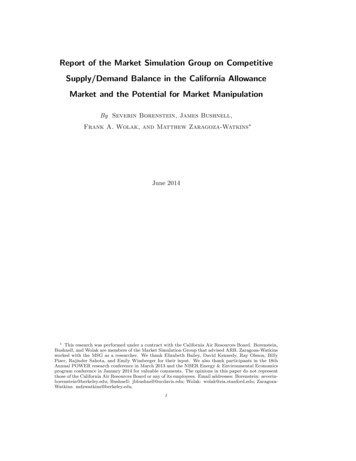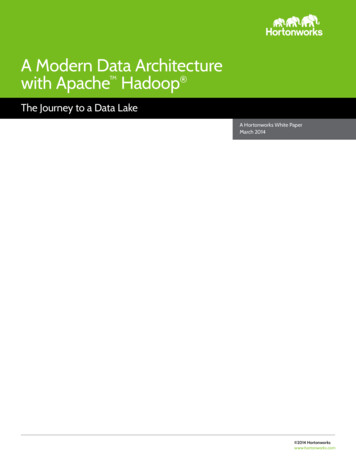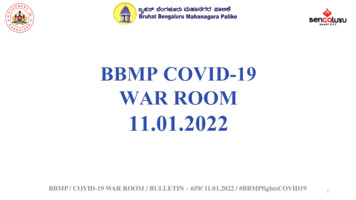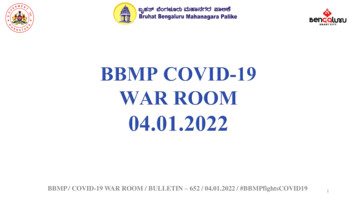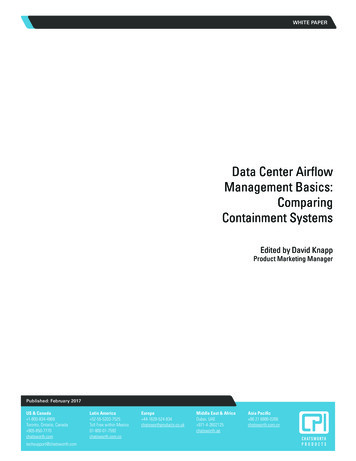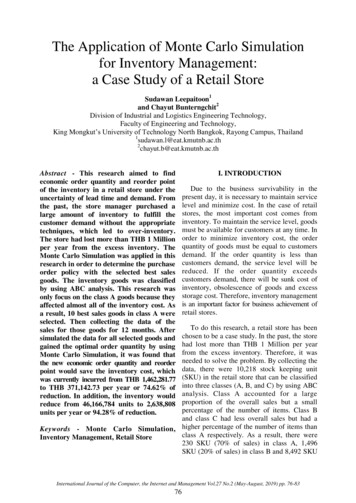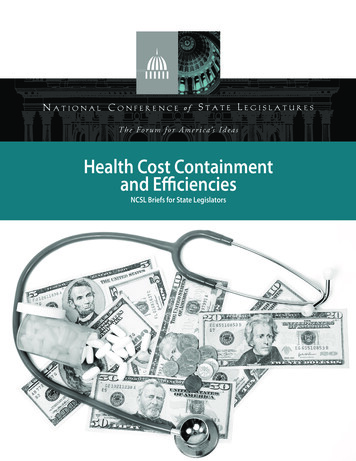
Transcription
Health Cost Containmentand EfficienciesNCSL Briefs for State Legislators
TABLE OF CONTENTS(Each individual brief in the series is numbered, #1-16 andincludes page numbers specific to that brief, four to six page each)CoverTable of ContentsIntroductionSeries I: Payment and Purchasing Reforms (Briefs No. 1-10)1. Administrative Simplification in the Health System2. Global Payments to Health Providers3. Episode-of-Care Payments4. Collecting Health Data: All-Payer Claims Databases5. Accountable Care Organizations6. Performance-Based Health Care Provider Payments7. Equalizing Health Provider Rates: All-Payer Rate Setting8. Use of Generic Prescription Drugs and Brand-Name Discounts9. Prescription Drug Agreements and Volume Purchasing10. Pooling Public Employee Health CareSeries II: Delivery System and Health Promotion Reforms (Briefs No. 11-16)11.Combating Fraud and Abuse12.Medical Homes13.Employer-Sponsored Health Promotion Programs14.Public Health and Cost Savings15.Health Care Provider Patient Safety16.Medical Malpractice
Health Cost Containmentand EfficienciesNCSL Briefs for State LegislatorsMay 2011A series examining options for containing or reducing health costs andimproving efficiency in health – expanded for 2011T3.Episode-of-Care Payments4.Collecting Health Data: All-Payer Claims Databases5.Accountable Care Organizations6.Performance-Based Health Care Provider PaymentsPolicymakers, especially at the state level, have spent agood deal of time and energy considering—and sometimes passing—laws and budgets aimed at controlling oreven cutting selected health expenditures. In recent years,a variety of health policy innovations and experimentshave been put into place to improve quality, control costand expand coverage. Many new approaches, already established in parts of the private, commercial market and instate and public sector programs, promise savings or improved affordability.7.Equalizing Health Provider Rates: All-Payer Rate Setting8.Use of Generic Prescription Drugs and Brand-Name Discounts9.Prescription Drug Agreements and Volume PurchasingSome health cost controls have medical consequences;some are obvious and some are unintended. During budget crises, for example, health programs may reduce coverage, shift costs to enrollees or phase out programs forspecial populations.12. Medical HomesSuccesses and Potential16. Medical Malpracticehe cost of health and health care in the United Statesfor years has been a highly visible topic of discussionfor consumers, employers, state and federal policymakers, and the media.Innovations and ExperimentsThis series of briefs takes a fresh approach by describinga number of health cost containment and cost efficiencyideas. Emphasis is on documented and fiscally calculatedresults, along with results that affect budgets, coverage,quality, prevention and wellness. Each brief describes 1)cost containment strategy and logic; 2) the target; 3) relation to the federal health reform law; 4) state and non-stateexamples; 5) evidence of effectiveness; 6) challenges andcomplementary approaches and 7) best sources for moreinformation. Where the results do not meet the intendedgoals, these reports present an objective appraisal, saying, for example, “Limited evidence is available . “ or “It isstill too early to determine ”The Topics for Series I: Paymentand Purchasing Reforms1.Administrative Simplification in the Health System2.Global Payments to Health Providers10. Pooling Public Employee Health CareThe Topics for Series II: Delivery System andHealth Promotion Reforms11. Combating Fraud and Abuse13. Employer-Sponsored Health Promotion Programs14. Public Health and Cost Savings15. Health Care Provider Patient SafetyFederal Health ReformSeveral cost containment approaches are included in the federal Patient Protection and Affordable Care Act, signed intolaw in March 2010. Some federal provisions build upon programs already used by some states. Other sections of the lawprovide new options, challenges and grant opportunities forstates that choose to create a new policy or program in futureyears. These examples are described in each brief where applicable.Future Updates and Forthcoming BriefsThe latest information and published material for this projectis available at www.ncsl.org/?tabid 19200. NCSL will continueintermittent publications of briefs in this series; new editionsand recent developments will be posted online.NCSL takes no position for or against any state law or proposed legislation. Materials and descriptions included inthese briefs do not constitute the opinion of NCSL, its members or staff.National Conference of State Legislatures
Health Cost Containment and Efficiency StrategiesStrategyCost Containment Strategyand LogicTarget of Cost Containment High health care systemEvidence of Effect on Costs1. AdministrativeSimplification in theHealth SystemStreamlining administrative functions in the currenthealth system (e.g., standardized forms and processes,streamlined claims processing,reduced and/or coordinatedgovernment regulations, etc.).2. Global Payments toHealth ProvidersA fixed prepayment made to Lack of financial incentivesa group of providers or healthfor providers to hold downcare system (as opposed to atotal care costs for a popuhealth care plan) for all care forlation of patients.all conditions for a population Inefficient, uncoordinatedof patients.care. Not enough attention tomanagement of chronicconditions. Prevention and early diagnosis and treatment.Research indicates global payments can result in lower costswithout affecting quality or access where providers are organized and have the data and systems to manage such payments.3. Episode-of-CarePaymentsA single payment for all care to Lack of financial incentivestreat a patient with a specificfor providers to manageillness, condition or medialthe total cost of care for anevent, as opposed to fee-forepisode of illness.service. Inefficient, uncoordinatedcare.Research is limited and showscost savings for some conditions.Payment mechanism is at an earlystage of development.4. Collecting HealthData: All-Payer ClaimsDatabasesA statewide repository of Inability to identify andhealth insurance claims inforreward high-quality/lowmation from all health carecost providers.payers, including health insur- Lack of data to enableers, government programs andconsumers to compareself-insured employer plans.provider prices and carequality.It is too early to determinewhether all-payer claims databases can help states control costs.5. Accountable CareOrganizations (ACOs)A local entity comprised of awide range of collaboratingproviders that is accountableto health care payers for theoverall cost and quality of carefor a defined population. Lack of a locus of account-6. Performance-BasedHealth Care ProviderPayments (P4P)Payments to providers formeeting pre-establishedhealth status, efficiency and/or quality benchmarks for agroup of patients. Providers not financially2administrative costs. Administrative inefficiencies associated with complex, uncoordinated, oftenduplicate regulatory andadministrative requirements.ability for overall healthcare costs and quality for apopulation of patients. Fragmented care.Studies are limited and indicatethat efforts to reduce administrative expenses have resulted insome efficiencies.Because it is a relatively new concept that has not been fully tested, there is insufficient evidenceto assess the effect on costs. Existing evidence is mixed.Research is limited and indicatesrewarded for providing ef- some improvements in quality officient, effective preventive care but little effect on costs.and chronic care. Unnecessary care.National Conference of State Legislatures
StrategyCost Containment Strategyand LogicTarget of Cost ContainmentEvidence of Effect on Costs7. Equalizing HealthProvider Rates: All-PayerRate SettingPayment rates that are thesame for all patients receivingthe same service or treatmentfrom the same provider. Ratescan be set by a state authorityor by providers themselves. High health care prices. Lack of price competition. Significant provider costs8. Use of GenericPrescription Drugs andBrand-Name DiscountsBuying more generic prescription drugs instead of theirbrand-name equivalents andpurchasing brand-name drugswith discounts can significantly reduce overall prescriptiondrug expenditures. State government-fundedExpanded use of generic drugsis documented to save states 30percent to 80 percent on certainwidely used medications, reducing expenditures by millions ofdollars annually.9. Prescription DrugAgreements and VolumePurchasingStates use combinations of approaches to control the costsof prescription drugs including: Preferred drug lists, Extra manufacturer pricerebates, Multistate purchasing andnegotiations, and Scientific studies on comparative effectiveness. Helps state governmentState Medicaid programs are using preferred drug lists, supplemental rebates and multi-statepurchasing arrangements tosave between 8 percent and 12percent on overall Medicaid drugpurchases.10. Pooling PublicEmployee Health CarePrograms that pool or combine High administrative costshealth insurance purchasersas a proportion of smallacross or beyond traditionaland mid-sized employerjurisdictions or associations,premiums.including public employee Limited ability of smallhealth coverage pools and priand mid-sized groups tovate sector health purchasingnegotiate lower healthalliances.care prices or premiums orbenefit.Evidence indicates arrangementsmay benefit small groups thatjoin large state pools but havenot slowed overall insurance premium increases.11. Combating Fraudand AbuseEvidence shows concertedstate anti-fraud and abuse efforts save states millions—andin some cases billions—of dollars each year, and states potentially could double or eventriple current collections.Medicaid expenditures forfraudulent claims cost statesbillions of dollars each year.It appears the more anti-fraudtools a state has at its disposal,the greater likelihood of fewerunwarranted payments and larger recoveries.12. Medical HomesSome studies show significantmedical home savings. Others have found minimal or nooverall savings but report other benefits, such as improvedquality of care, fewer medicalerrors and enhanced healthcare access.Medical homes are designedto address several shortcomings in the current health caresystem, especially uncoordinated care. Poor care coordination is associated with duplicate procedures, conflictingtreatment recommendations,unnecessary hospitalizationsand nursing home placements, and adverse drug reactions.Most studies that support medical homes’ potential to reduceoverall spending have not assessed a complete version of theapproach.Evidence is mixed but indicatesthat, properly structured, stateall-payer rate setting can slowto negotiate, track andprice increases but not necessarprocess claims under many ily overall cost growth.reimbursement schedules.pharmaceutical purchasing, including Medicaid,state-only programs andsome private-market pharmaceutical purchasing.public sector programsoperate more efficientlyand cost effectively. Holds down overall statepharmaceutical spending,but does not deny coverage or services to individual patients.National Conference of State Legislatures3
StrategyCost Containment Strategyand LogicTarget of Cost ContainmentEvidence of Effect on Costs13. Employer-SponsoredHealth PromotionProgramsEvidence indicates that welldesigned worksite wellnessprograms can reduce healthexpenditures and reduce absenteeism, at least for largeemployers, including stategovernment.The main targets of worksite wellness programs arechronic diseases, such asdiabetes, chronic obstructivepulmonary disease and heartdisease.Research for this brief did notuncover any studies of the effectiveness of state laws to encourage more employers to offer, ormore employees to participate in,worksite wellness programs.14. Public Health andCost SavingsEvidence indicates publichealth programs improvehealth, extend longevity andcan reduce health care expenditures.Public health programs protect and improve the healthof communities by preventingdisease and injury, reducinghealth hazards, preparingfor disasters, and promotinghealthy lifestyles.Extensive research documentsthe health benefits of moreAmericans exercising, losingweight, not using tobacco, driving safely and engaging in otherhealthy habits. Less clear is theeffect on total health care costs.15. Health Care ProviderPatient SafetyMedical errors are the eighthleading cause of death in theUnited States, higher than motor vehicle accidents, breastcancer or AIDS. Each year, between 500,000 and 1.5 millionAmericans admitted to hospitals are harmed by preventablemedical errors.The estimated annual cost ofadditional medical and shortterm disability expenses associated with medical errors is 19.5 billion. Longer hospitalstays and the cost of treatingmedical error-related injuriesand complications are the twomajor expenditures associated with medical errors.Examples of patient safety initiatives that improve patientcare and reduce costs exist, butevidence of overall savings islimited. Recent strategies includeE-prescribing, non-payment for“never events,” regulating medicalwork conditions and error reporting.About this projectNCSL’s Health Cost Containment and Efficiency Series describes various alternative statepolicy approaches, with an emphasis on documented and fiscally calculated results. The project is housed at the NCSL Health Program in Denver, Colorado. It is led by Richard Cauchi(program director) and Martha King (group director); Barbara Yondorf is lead researcher. KatieMason and Leann Stelzer provide editorial review and publication management.NCSL gratefully acknowledges the financial support for this publication series fromThe Colorado Health Foundation and Rose Community Foundation of Denver, Colorado.National Conference of State LegislaturesWilliam T. Pound, Executive Director7700 East First PlaceDenver, Colorado 80230(303) 364-7700444 North Capitol Street, N.W., #515Washington, D.C. 20001(202) 624-5400www.ncsl.org 2011 by the National Conference of State Legislatures. All rights reserved.Health Cost Containment and Efficiencies Series 1: ISBN 978-1-58024-600-2Item # 063010HEAPrice: 454National Conference of State Legislatures
Health Cost Containmentand EfficienciesNCSL Briefs for State LegislatorsNo. 1May 2010Administrative Simplification in the Health SystemCost Containment Strategy and LogicAdministrative simplification refers to efforts to streamlineadministrative functions in the current health system.1Administrative simplification includes programs that:n Promote or require use of standardized, commonelectronic or paper forms (e.g., for billing and coding);n Improve the efficiency of provider-insurer transactions in claims processing and payment;n Institute a single process for verifying provider (forexample doctors, specialists, nurses) experience andeducation that is recognized by all parties, as opposed to having separate processes for each healthplan, hospital and practice that requires providers toverify their credentials before hiring or paying them;n Give providers and patients instant access to a patient’s insurance coverage information (e.g., servicescovered, required copayments and caps on benefits)using a magnetic swipe card;n Standardize medical management policies (e.g., preauthorization procedures); andn Streamline government regulations and compliancerequirements.Target of CostContainmentEvidence indicates thatefforts to reduce administrative expenses haveresulted in some efficiencies.The primary goal of administrative simplification effortsis to lower costs by reducing duplication and unnecessary complexity in healthcare system operations. A 2009 report on improving healthcare purchasing in Minnesota observed, “Because routine administrative transactions such as checking patient eligibility forbenefits, submitting bills for services, or making payments toproviders occur every minute, every day, millions of times eachyear, even small inefficiencies add up to be significant costsand drags on health system productivity.”2Administrative simplification initiatives are aimed mainly athow health providers and insurers conduct business, especiallywith one another.An example of administrative inefficiency concerns the wayhealth care billings are processed. Studies suggest that paperbilling—the traditional and still most widely used method—costs nearly twice as much ( 1.58 per claim) as electronic billing( .85 per claim).3 Provider credential verification also typicallyBy streamlining and standardizing routine business prois inefficient. One group has estimated that the average healthcesses, administrative simplification can help to reduceplan spends approximately 500,000 annually on credentialingunnecessary and duplicative transaction costs and thusactivities, and the average provider spends up to 6.5 hours anreduce overall health care expenditures.nually.4 Processing bills is another source of unnecessarily highadministrative expenses. According to theFigure 1. Total Annual Cost to U.S. Physician Practices for Interacting withAmerican Medical Association, physician pracHealth Plans Is Estimated at 31 Billion*tices spend as much as 14 percent of their toMDstal collections to ensure accurate payment forclerical 15,767services. This amounts to more than 68,000Clerical staffper physician practice (Figure 1). Researcherslawyer 15,767estimate that provider and health plan adminsristrativeadmincosts together account for 25 percentTotal Annual perPractice Cost peror more of the cost of private health insurancePhysician: 68,274nursecoverage.5Lawyer/accountant 15,767Senior administrative 15,767Nursing staff 21,796*Based on an estimated 453,696 office-based physicians.Source: L.P. Casalino et al., “What Does it Cost Physician Practices to Interact with HealthInsurance Plans?” Health Affairs Web Exclusive, May 14, 2009, w533-w543.mdFederal Health ReformThe Patient Protection and Affordable CareAct, signed March 23, 2010, contains severaladministrative streamlining provisions. Examples include adopting a single set of operating rules for eligibility verification and claimsstatus (effective Jan. 1, 2013); electronic fundstransfer and health care payment and remit-National Conference of State Legislatures
tances (effective Jan. 1, 2014); and health claims processing,enrollment and disenrollment, premium payments, and referral certification and authorization (effective Jan. 1, 2016).standard claims submissions. Maine, for example, requires providers to submit their claims to insurers in a standardized electronic format.State Examplesn A 2005 Maine law was designed not only to reduce administrative costs, but also to ensure that savings are passed tohealth care purchasers.7 The law establishes an administrativestreamlining work group to “ facilitate the creation and implementation of a single portal through which hospitals can access and transmit member eligibility, benefit and claims information from multiple insurers.” The work group is responsiblefor investigating ways to ensure that savings from implementation of the portal are passed to purchasers in the form of ratereductions by hospitals and other providers and by reductionsin administrative costs by insurers and third-party administrators.n Several states have conducted studies to estimate the potential savings from various administrative simplification initiatives. For example, the Oregon Health Fund Board estimatedthat, over 10 years, developing and requiring all plans to useuniform forms and processes for administrative transactionscould save 350 million in health-plan-related transaction costs.Limiting the allowable increase in the administrative portionof insurance premiums to a measure of general inflation couldsave as much as 1.4 billion over 10 years in health insurancepremium costs. Minnesota’s Center for Health Care PurchasingImprovement calculated that requiring providers and insurersto conduct all administrative transactions electronically usingstandard data and content could reduce overall costs in Minnesota’s health care system (both public and private) by morethan 60 million per year by 2013.n At least 15 states require or encourage use of a standard provider application for credentialing—a nationally recognizedapplication and/or a state-specific one. West Virginia is amongthe most recent states to enact legislation that sets up a processdesigned to lead to a standard credentialing system.6 In mostcases, states have designated the standard provider application developed by the Council for Affordable Quality Healthcare (CAQH) as their required or acceptable provider credentialing form. Louisiana, New Jersey and Tennessee, for example,require or allow health plans to use either the standard CAQHapplication or a state-specific alternative. Vermont requires useof the CAQH application form.n An increasing number of states are encouraging or requiringhealth plans to provide enrollees with health insurance swipecards. Swipe cards, which would replace paper ID cards, havemagnetic strips that give patients and providers immediate access to information about a patient’s health insurance benefits(e.g., deductibles and copayments). Most states are considering the uniform standards recommended by the Workgroupfor Electronic Data Interchange (WEDI), a broad-based, national health care industry association. Utah enacted legislationin 2009 (HB 165) that moves the state toward a standardizedswipe card and changes how hospitals and health care providers send information and billing to patients. Colorado’s 2008law (SB 08-135) requires health insurers to issue standardized,printed identification cards and authorizes the commissionerof insurance to adopt rules requiring insurers to use standardswipe cards or other appropriate technology in the future.n States are considering a standardized claims processing system for all payers. The Oregon Health Policy Commission recommended in its 2007 road map for health care reform that thestate continue its efforts to create a statewide simplified andstandardized claims processing system, using its influence as apurchaser and as a key regulator. Several states already require2n Several states have either passed a series of bills to streamline various administrative processes or have enacted comprehensive administrative simplification bills.—A 2007 Minnesota law required all health care providers andpayers to use a single electronic standard for the transmission,content and format of payment records, claims and eligibility verifications, beginning in 2009.8 In 2009, the Legislaturepassed technology standards legislation (HF 384B) that prescribes a process for adopting rules to implement a standardized electronic swipe card all health plans must use.—A 2008 Massachusetts law requires health insurers and providers to adopt statewide, uniform, consistent and standardized billing and coding processes by 2012.9 The state is alsoconsidering ways to reduce duplicative or conflicting stateregulatory requirements. State agencies that regulate healthproviders and plans are collaborating to consider the cost containment potential and feasibility of creating a uniform system and format for similar reports required by multiple stateagencies. Examples of such filings include reports of injuries,adverse medical events, frequency of filing claims informationand membership data. The Division of Insurance and the attorney general’s office are responsible for holding hearings for insurance companies that submit rate increases above 7 percent,paying particular attention to the companies’ administrativecosts and executive compensation. The state also is considering moving health plan licensure from every year to every twoyears.—Washington enacted comprehensive administrative streamlining legislation in 2009.10 The Health Care Efficiency Act requires development and implementation of a uniform providercredentialing process; a uniform standard document and dataset for electronic eligibility and coverage verification; codestandardization; and common and consistent time frames forreviewing requests for medical management protocols (e.g.,prior authorization and preadmission requirements).National Conference of State Legislatures
n Several states have established or are considering creatingadvisory groups or offices responsible for identifying ways toreduce administrative expenses. Maine established an Administrative Streamlining Workgroup authorized by a 2005 law.11 Ina 2008 report, the Oregon Health Fund Board recommendedthat the Division of Insurance convene a work group to developuniform forms and processes for administrative transactions.12Non-State Examplesn A national group, the Committee on Operating Rules forInformation Exchange, is working to build consensus amonghealth care industry stakeholders on a set of operating rulesfor administrative interoperability between health plans andproviders to streamline provider-plan transactions. It currentlyis working to develop rules for immediate electronic verification of patients’ health plan coverage; determination of claimsstatus; processing prior authorizations; and standard medicalidentification cards. Among the government agencies participating in CORE are Louisiana Medicaid and theMinnesota Department of Human Resources.n Humana Health launched a swipe card pilotprogram in two Florida cities in 2007. Sincethen, the project has spread statewide and toseven other states. United Healthcare also hasadopted swipe card technology; more than20 million of its members have electronic IDcards.before a patient leaves the office. The company reported that a10-physician Texas practice participating in the pilot programsaved 14,000 in billing costs in a year. Another practice reduced accounts receivable by 13 percent and decreased theaverage time to collect insurer and patient payments from 45days to six. For some practices, however, implementing realtime claims adjudication is complicated and can require achange in physician office billing and collections procedures.15Although administrative streamlining appears to have resultedin some savings, for the most part it has not yet reduced costsfor purchasers. A comprehensive research report concluded,“Evidence is lacking on whether improvements in the efficiency of insurance companies will be translated into reductions inpremiums for their customers.”16 The report continued: “Similarly, it is uncertain whether improvements in hospital efficiency will be translated into reductions in charges for services.”It found no evidence to prove that any specific interventionswould reduce overall costs.Several states have eitherpassed a series of bills tostreamline various administrative processes or have enactedcomprehensive administrativesimplification bills.Evidence of EffectivenessLimited evidence indicates that efforts to reduce administrative expenses have resulted in some efficiencies. Unfortunately, most of the literature on administrative streamlining focusesmore on estimates of current administrative expenditures rather than on demonstrated savings from administrative simplification. Existing evidence comes mainly from the private sector;no studies of the results of state administrative simplificationefforts were found. The results of three private sector initiativesare discussed belown IBM assessed the results achieved by health plans that adopted some initial CORE rules for administrative interoperability described previously. It found that electronic verification ofpatients’ benefit coverage (e.g., deductible and copayments)took about seven minutes less than telephone verification, saving about 2.10 per verification.13n Blue Cross and Blue Shield of South Carolina’s Web-basedtool, My Insurance Manager Web Precert, allows providers to receive immediate resolution of some pre-certification requests,verifying member eligibility for procedures, medications andother services. In 2007, it reported that the system created efficiencies credited with savings of 1.4 million.14Challengesn Significant cost savings from administrativereforms have not been realized or appeared inthe form of lower costs for purchasers for several possible reasons.n Many efforts to streamline administrativefunctions are relatively new and have not beenwidely enough adopted to realize overall savings.n Programs designed to reduce overhead often have significant front-end costs (e.g., new computer systems and trainingpersonnel). As a result, a net benefit may not be realized forseveral years.n It can be difficult for payers to capture the savings associatedwith efficiencies realized at the provider or plan level. Plans andproviders may retain the savings rather than pass them alongto payers.n Some targets of administrative simplification account for arelatively small part of health care costs. For example, a Washington report on administrative simplification found that, while“provider credentialing is a source of administrative variationand waste that generates provider frustration, it does not appear to be a major source of cost to providers, plans or hospitals.” 17n Some health policy analysts have argued that a greater overhaul of the system beyond simply streamlining current administrative functions is needed to realize savings. This might include substantially reforming the health care payment system,limiting the number of allowable benefit designs and prohibiting exclusion of preexisting conditions, or establishing a singlepayer system.n UnitedHealthcare is testing immediate claims adjudication,which allows a claim to be submitted to an insurer and settledNational Conference of State Legislatures3
For More InformationEibner, Christine, et al. Controlling Health
A series examining options for containing or reducing health costs and improving efficiency in health - expanded for 2011 National Conference of State Legislatures T he cost of health and health care in the United States for years has been a highly visible topic of discussion for consumers, employers, state and federal policy-makers, and the .


